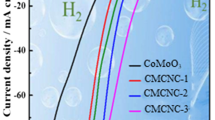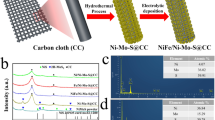Abstract
Non-noble metal electrocatalysts for water cracking have excellent prospects for development of sustainable and clean energy. Highly efficient electrocatalysts for the oxygen evolution reaction (OER) are very important for various energy storage and conversion systems such as water splitting devices and metal-air batteries. This study prepared a NiMo4@C3N4 catalyst for OER and hydrogen evolution reaction (HER) by simple methods. The catalyst exhibited an excellent OER activity based on the response at a suitable temperature. To drive a current density of 10 mA·cm−2 for OER and HER, the overpotentials required for NiMo4@C3N4-800 (prepared at 800 °C) were 259 and 118 mV, respectively. A two-electrode system using NiMo4@C3N4-800 needed a very low cell potential of 1.572 V to reach a current density of 10 mA·cm−2. In addition, this catalyst showed excellent durability after long-term tests. It was seen to have good catalytic activity and broad application prospects.
Similar content being viewed by others
References
Zhang X, Yan F, Ma X, et al. Regulation of morphology and electronic structure of FeCoNi layered double hydroxides for highly active and stable water oxidization catalysts. Advanced Energy Materials, 2021, 11(48): 2102141
Gray H B. Powering the planet with solar fuel. Nature Chemistry, 2009, 1(2): 112
Fan J, Wu J, Cui X, et al. Hydrogen stabilized RhPdH 2D bimetallene nanosheets for efficient alkaline hydrogen evolution. Journal of the American Chemical Society, 2020, 142(7): 3645–3651
Turner J A. Sustainable hydrogen production. Science, 2004, 305(5686): 972–974
Shi Y, Zhang B. Recent advances in transition metal phosphide nanomaterials: synthesis and applications in hydrogen evolution reaction. Chemical Society Reviews, 2016, 45(6): 1529–1541
Anantharaj S, Ede S R, Karthick K, et al. Precision and correctness in the evaluation of electrocatalytic water splitting: revisiting activity parameters with a critical assessment. Energy & Environmental Science, 2018, 11(4): 744–771
Kanan M W, Nocera D G. In situ formation of an oxygen-evolving catalyst in neutral water containing phosphate and Co2+. Science, 2008, 321(5892): 1072–1075
Walter M G, Warren E L, McKone J R, et al. Solar water splitting cells. Chemical Reviews, 2010, 110(11): 6446–6473
Ye S, Xiong W, Liao P, et al. Removing the barrier to water dissociation on single-atom Pt sites decorated with a CoP mesoporous nanosheet array to achieve improved hydrogen evolution. Journal of Materials Chemistry A, 2020, 8(22): 11246–11254
Zhang B, Wang L, Cao Z, et al. High-valence metals improve oxygen evolution reaction performance by modulating 3d metal oxidation cycle energetics. Nature Catalysis, 2020, 3(12): 985–992
Anantharaj S, Kundu S, Noda S. “The Fe Effect”: A review unveiling the critical roles of Fe in enhancing OER activity of Ni and Co based catalysts. Nano Energy, 2021, 80: 105514
Jiao Y, Zheng Y, Jaroniec M, et al. Design of electrocatalysts for oxygen- and hydrogen-involving energy conversion reactions. Chemical Society Reviews, 2015, 44(8): 2060–2086
Dresselhaus M S, Thomas I L. Alternative energy technologies. Nature, 2001, 414(6861): 332–337
Li X, Hao X, Abudula A, et al. Nanostructured catalysts for electrochemical water splitting: current state and prospects. Journal of Materials Chemistry A, 2016, 4(31): 11973–12000
Reier T, Oezaslan M, Strasser P. Electrocatalytic oxygen evolution reaction (OER) on Ru, Ir, and Pt catalysts: a comparative study of nanoparticles and bulk materials. ACS Catalysis, 2012, 2(8): 1765–1772
Zhang J, Wang T, Liu P, et al. Efficient hydrogen production on MoNi4 electrocatalysts with fast water dissociation kinetics. Nature Communications, 2017, 8: 15437
Suntivich J, May K J, Gasteiger H A, et al. A perovskite oxide optimized for oxygen evolution catalysis from molecular orbital principles. Science, 2011, 334(6061): 1383–1385
Singh A, Chang S L Y, Hocking R K, et al. Highly active nickel oxide water oxidation catalysts deposited from molecular complexes. Energy & Environmental Science, 2013, 6(2): 579–586
Zhang B, Zheng X, Voznyy O, et al. Homogeneously dispersed multimetal oxygen-evolving catalysts. Science, 2016, 352(6283): 333–337
Trotochaud L, Young S L, Ranney J K, et al. Nickel-iron oxyhydroxide oxygen-evolution electrocatalysts: the role of intentional and incidental iron incorporation. Journal of the American Chemical Society, 2014, 136(18): 6744–6753
Gao M, Sheng W, Zhuang Z, et al. Efficient water oxidation using nanostructured α-nickel-hydroxide as an electrocatalyst. Journal of the American Chemical Society, 2014, 136(19): 7077–7084
Song F, Hu X. Ultrathin cobalt-manganese layered double hydroxide is an efficient oxygen evolution catalyst. Journal of the American Chemical Society, 2014, 136(47): 16481–16484
Ping J, Wang Y, Lu Q, et al. Self-assembly of single-layer CoAl-layered double hydroxide nanosheets on 3D graphene network used as highly efficient electrocatalyst for oxygen evolution reaction. Advanced Materials, 2016, 28(35): 7640–7645
Zhu J, Sakaushi K, Clavel G, et al. A general salt-templating method to fabricate vertically aligned graphitic carbon nanosheets and their metal carbide hybrids for superior lithium ion batteries and water splitting. Journal of the American Chemical Society, 2015, 137(16): 5480–5485
Chen W F, Muckerman J T, Fujita E. Recent developments in transition metal carbides and nitrides as hydrogen evolution electrocatalysts. Chemical Communications, 2013, 49(79): 8896–8909
Ham D, Lee J. Transition metal carbides and nitrides as electrode materials for low temperature fuel cells. Energies, 2009, 2(4): 873–899
Wan C, Leonard B M. Iron-doped molybdenum carbide catalyst with high activity and stability for the hydrogen evolution reaction. Chemistry of Materials, 2015, 27(12): 4281–4288
Huang Y, Gong Q, Song X, et al. Mo2C nanoparticles dispersed on hierarchical carbon microflowers for efficient electrocatalytic hydrogen evolution. ACS Nano, 2016, 10(12): 11337–11343
Wang Z C, Liu H L, Ge R X, et al. Phosphorus-doped Co3O4 nanowire array: a highly efficient bifunctional electrocatalyst for overall water splitting. ACS Catalysis, 2018, 8(3): 2236–2241
Xu K, Chen P, Li X, et al. Metallic nickel nitride nanosheets realizing enhanced electrochemical water oxidation. Journal of the American Chemical Society, 2015, 137(12): 4119–4125
Chen W F, Sasaki K, Ma C, et al. Hydrogen-evolution catalysts based on non-noble metal nickel-molybdenum nitride nanosheets. Angewandte Chemie International Edition, 2012, 51(25): 6131–6135
Shalom M, Molinari V, Esposito D, et al. Sponge-like nickel and nickel nitride structures for catalytic applications. Advanced Materials, 2014, 26(8): 1272–1276
Zhai M, Wang F, Du H. Transition-metal phosphide-carbon nanosheet composites derived from two-dimensional metal-organic frameworks for highly efficient electrocatalytic water-splitting. ACS Applied Materials & Interfaces, 2017, 9(46): 40171–40179
Sun M, Liu H, Qu J, et al. Earth-rich transition metal phosphide for energy conversion and storage. Advanced Energy Materials, 2016, 6(13): 1600087
Zhang G, Wang G, Liu Y, et al. Highly active and stable catalysts of phytic acid-derivative transition metal phosphides for full water splitting. Journal of the American Chemical Society, 2016, 138(44): 14686–14693
Li S, Zhang G, Tu X, et al. Polycrystalline CoP/CoP2 structures for efficient full water splitting. ChemElectroChem, 2018, 5(4): 701–707
Lacroix P G, Munoz M C, Gaspar A B, et al. Crystal structures, and solid state quadratic nonlinear optical properties of a series of stilbazolium cations combined with gold cyanide counter-ion. Journal of Materials Chemistry, 2011, 21(40): 15940–15949
Masa J, Sinev I, Mistry H, et al. Ultrathin high surface area nickel boride (NixB) nanosheets as highly efficient electrocatalyst for oxygen evolution. Advanced Energy Materials, 2017, 7(17): 1700381
Zhu H, Jiang R, Chen X, et al. 3D nickel-cobalt diselenide nanonetwork for highly efficient oxygen evolution. Science Bulletin, 2017, 62(20): 1373–1379
Shi Y, Zhou Y, Yang D R, et al. Energy level engineering of MoS2 by transition-metal doping for accelerating hydrogen evolution reaction. Journal of the American Chemical Society, 2017, 139(43): 15479–15485
Zheng W, Sun H, Li X, et al. Fe-doped NiCo2O4 hollow hierarchical sphere as an efficient electrocatalyst for oxygen evolution reaction. Frontiers of Materials Science, 2021, 15(4): 577–588
Wang Y, Xie C, Liu D, et al. Nanoparticle-stacked porous nickel-iron nitride nanosheet: a highly efficient bifunctional electrocatalyst for overall water splitting. ACS Applied Materials & Interfaces, 2016, 8(29): 18652–18657
Wu H, Feng C, Zhang L, et al. Non-noble metal electrocatalysts for the hydrogen evolution reaction in water electrolysis. Electrochemical Energy Reviews, 2021, 4(3): 473–507
Yin Z, Sun Y, Jiang Y, et al. Hierarchical cobalt-doped molybdenum-nickel nitride nanowires as multifunctional electrocatalysts. ACS Applied Materials & Interfaces, 2019, 11(31): 27751–27759
Friebel D, Louie M W, Bajdich M, et al. Identification of highly active Fe sites in (Ni,Fe)OOH for electrocatalytic water splitting. Journal of the American Chemical Society, 2015, 137(3): 1305–1313
Burke M S, Kast M G, Trotochaud L, et al. Cobalt-iron (oxy)hydroxide oxygen evolution electrocatalysts: the role of structure and composition on activity, stability, and mechanism. Journal of the American Chemical Society, 2015, 137(10): 3638–3648
Yin Z X, Zhang S, Chen W, et al. Hybrid-atom-doped NiMoO4 nanotubes for oxygen evolution reaction. New Journal of Chemistry, 2020, 44(40): 17477–17482
Yin Z X, Zhang S, Li J L, et al. In-situ fabrication of Ni−Fe−S hollow hierarchical sphere: an efficient (pre)catalyst for OER and HER. New Journal of Chemistry, 2021, 45(29): 12996–13003
Chen P, Xu K, Fang Z, et al. Metallic Co4N porous nanowire arrays activated by surface oxidation as electrocatalysts for the oxygen evolution reaction. Angewandte Chemie International Edition, 2015, 54(49): 14710–14714
Xie J, Zhang J, Li S, et al. Correction to controllable disorder engineering in oxygen incorporated MoS2 ultrathin nanosheets for efficient hydrogen evolution. Journal of the American Chemical Society, 2014, 136(4): 1680
Shalom M, Ressnig D, Yang X F, et al. Nickel nitride as an efficient electrocatalyst for water splitting. Journal of Materials Chemistry A: Materials for Energy and Sustainability, 2015, 3(15): 8171–8177
Xu X, Luo F, Tang W, et al. Enriching hot electrons via NIR-photon-excited plasmon in WS2@Cu hybrids for full-spectrum solar hydrogen evolution. Advanced Functional Materials, 2018, 28(43): 1804055
Wang F, Sun Y, He Y, et al. Highly efficient and durable MoNiNC catalyst for hydrogen evolution reaction. Nano Energy, 2017, 37: 1–6
Wang T, Wu H, Feng C, et al. Ni, N-coped NiMoO4 grown on 3D nickel foam as bifunctional electrocatalysts for hydrogenproduction in urea-water electrolysis. Electrochimica Acta, 2021, 391: 138931
Cao F, Zhao M, Yu Y, et al. Synthesis of two-dimensional CoS1.097/nitrogen-doped carbon nanocomposites using metal-organic framework nanosheets as precursors for supercapacitor application. Journal of the American Chemical Society, 2016, 138(22): 6924–6927
Faber M S, Park K, Cabán-Acevedo M, et al. Earth-abundant cobalt pyrite (CoS2) thin film on glass as a robust, high-performance counter electrode for quantum dot-sensitized solar cells. The Journal of Physical Chemistry Letters, 2013, 4(11): 1843–1849
Xing W, Zhang Y, Xue Q, et al. Highly active catalyst of two-dimensional CoS2/graphene nanocomposites for hydrogen evolution reaction. Nanoscale Research Letters, 2015, 10: 488
Novoselov K S, Geim A K, Morozov S V, et al. Two-dimensional gas of massless Dirac fermions in graphene. Nature, 2005, 438(7065): 197–200
Yang Y, Li F, Li W, et al. Porous CoS2 nanostructures based on ZIF-9 supported on reduced graphene oxide: favourable electrocatalysis for hydrogen evolution reaction. International Journal of Hydrogen Energy, 2017, 42(10): 6665–6673
Guo Z, Sun T, Li Y, et al. Large surface and pore structure of mesoporous WS2 and RGO nanosheets with small amount of Pt as a highly efficient electrocatalyst for hydrogen evolution. International Journal of Hydrogen Energy, 2018, 43(51): 22905–22916
Lu C, Tranca D, Zhang J, et al. Molybdenum carbide-embedded nitrogen-doped porous carbon nanosheets as electrocatalysts for water splitting in alkaline media. ACS Nano, 2017, 11(4): 3933–3942
Yin Z, Sun Y, Zhu C, et al. Bimetallic Ni-Mo nitride nanotubes as highly active and stable bifunctional electrocatalysts for full water splitting. Journal of Materials Chemistry A, 2017, 5(26): 13648–13658
Zhu C, Yin Z, Lai W, et al. Fe-Ni-Mo nitride porous nanotubes for full water splitting and Zn-air batteries. Advanced Energy Materials, 2018, 8(36): 1802327
Acknowledgements
This work was supported by the Department of Education Basic Research Operating Costs of Heilongjiang Province, China (Grant No. 300663).
Author information
Authors and Affiliations
Corresponding authors
Additional information
Disclosure of potential conflicts of interests
The authors declare no conflict of interest in the content of this work.
Electronic supplementary material
Rights and permissions
About this article
Cite this article
Li, X., Zhou, M., Yin, Z. et al. Bimetallic Ni-Mo nitride@C3N4 for highly active and stable water catalysis. Front. Mater. Sci. 16, 220613 (2022). https://doi.org/10.1007/s11706-022-0613-9
Received:
Accepted:
Published:
DOI: https://doi.org/10.1007/s11706-022-0613-9




